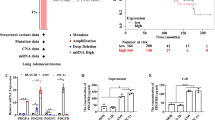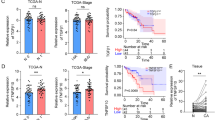Abstract
Substantial evidence has demonstrated that platelet-derived growth factor-D (PDGF-D) is tightly associated with the development and progression of tumors. However, its biological functions in esophageal squamous cell carcinoma (ESCC) remain to be delineated. In this study, we found that expressions of PDGF-D mRNA and protein in ESCC tissues and cells were significantly higher than that in normal esophageal epithelial tissues (P < 0.05), further investigation showed that PDGF-D protein level in EC1 cells was obviously higher than those in EC9706 and Eca109 cells (P < 0.05). Elevated PDGF-D level was closely associated with TNM staging, tumor differentiation and lymph node metastasis (P < 0.05), but not related to the patients’ age and gender (P > 0.05). In addition, down-regulation of PDGF-D expression markedly inhibited proliferation, reduced invasion and induced apoptosis in EC1 cells. More importantly, reduced PDGF-D level evoked the down-regulation of p65 and p-IκBα proteins and elevation of IκBα protein of NF-κB pathway, accompanied with the decreases of bcl-2 and MMP-9 protein expressions and increases of bax protein level and caspase-3 activities. Correctively, our data suggest that PDGF-D plays pivotal roles in the development and progression of ESCC, and combinations with PDGF-D and NF-κB pathway may be effective and feasible molecular targets for therapy of ESCC.







Similar content being viewed by others
References
Ilson DH, Kelsen DP (1994) Combined modality therapy in the treatment of esophageal cancer. Semin Oncol 21(4):493–507
Pisani P, Parkin DM, Bray F, Ferlay J (1999) Estimates of the worldwide mortality from 25 cancers in 1990. Int J Cancer 83(1):18–29
Yang CS (1980) Research on esophageal cancer in China: a review. Cancer Res 40(8 Pt 1):2633–2644
Ekman S, Dreilich M, Lennartsson J, Wallner B, Brattstrom D, Sundbom M, Bergqvist M (2008) Esophageal cancer: current and emerging therapy modalities. Expert Rev Anticancer Ther 8(9):1433–1448
Hiyama T, Yoshihara M, Tanaka S, Chayama K (2007) Genetic polymorphisms and esophageal cancer risk. Int J Cancer 121(8):1643–1658
Mandard AM, Hainaut P, Hollstein M (2000) Genetic steps in the development of squamous cell carcinoma of the esophagus. Mutat Res 462(2–3):335–342
Stoner GD, Gupta A (2001) Etiology and chemoprevention of esophageal squamous cell carcinoma. Carcinogenesis 22(11):1737–1746
Enzinger PC, Mayer RJ (2003) Esophageal cancer. N Engl J Med 349(23):2241–2252
La Madrid AM, Campbell N, Smith S, Cohn SL, Salgia R (2012) Targeting ALK: a promising strategy for the treatment of non-small cell lung cancer, non-Hodgkin’s lymphoma, and neuroblastoma. Target Oncol 7(3):199–210
Guo JX, Tao QS, Lou PR, Chen XC, Chen J, Yuan GB (2012) miR-181b as a potential molecular target for anticancer therapy of gastric neoplasms. Asian Pac J Cancer Prev 13(5):2263–2267
Andrae J, Gallini R, Betsholtz C (2008) Role of platelet-derived growth factors in physiology and medicine. Genes Dev 22(10):1276–1312
Ross R (1987) Platelet-derived growth factor. Annu Rev Med 38:71–79
Heldin CH, Westermark B (1999) Mechanism of action and in vivo role of platelet-derived growth factor. Physiol Rev 79(4):1283–1316
Heldin CH, Hammacher A, Nister M, Westermark B (1988) Structural and functional aspects of platelet-derived growth factor. Br J Cancer 57(6):591–593
Yu J, Ustach C, Kim HR (2003) Platelet-derived growth factor signaling and human cancer. J Biochem Mol Biol 36(1):49–59
Wang Z, Kong D, Li Y, Sarkar FH (2009) PDGF-D signaling: a novel target in cancer therapy. Curr Drug Targets 10(1):38–41
Ustach CV, Taube ME, Hurst NJ Jr, Bhagat S, Bonfil RD, Cher ML, Schuger L, Kim HR (2004) A potential oncogenic activity of platelet-derived growth factor d in prostate cancer progression. Cancer Res 64(5):1722–1729
Ustach CV, Kim HR (2005) Platelet-derived growth factor D is activated by urokinase plasminogen activator in prostate carcinoma cells. Mol Cell Biol 25(14):6279–6288
Wang Z, Kong D, Banerjee S, Li Y, Adsay NV, Abbruzzese J, Sarkar FH (2007) Down-regulation of platelet-derived growth factor-D inhibits cell growth and angiogenesis through inactivation of Notch-1 and nuclear factor-kappaB signaling. Cancer Res 67(23):11377–11385
Xu L, Tong R, Cochran DM, Jain RK (2005) Blocking platelet-derived growth factor-D/platelet-derived growth factor receptor beta signaling inhibits human renal cell carcinoma progression in an orthotopic mouse model. Cancer Res 65(13):5711–5719
Wang Y, Hu C, Dong R, Huang X, Qiu H (2011) Platelet-derived growth factor-D promotes ovarian cancer invasion by regulating matrix metalloproteinases 2 and 9. Asian Pac J Cancer Prev 12(12):3367–3370
Zhao L, Zhang C, Liao G, Long J (2010) RNAi-mediated inhibition of PDGF-D leads to decreased cell growth, invasion and angiogenesis in the SGC-7901 gastric cancer xenograft model. Cancer Biol Ther 9(1):42–48
Lokker NA, Sullivan CM, Hollenbach SJ, Israel MA, Giese NA (2002) Platelet-derived growth factor (PDGF) autocrine signaling regulates survival and mitogenic pathways in glioblastoma cells: evidence that the novel PDGF-C and PDGF-D ligands may play a role in the development of brain tumors. Cancer Res 62(13):3729–3735
Liu Y, Li K, Ren Z, Li S, Zhang H, Fan Q (2012) Clinical implication of elevated human cervical cancer oncogene-1 expression in esophageal squamous cell carcinoma. J Histochem Cytochem 60(7):512–520
Li S, Jiao J, Lu Z, Zhang M (2009) An essential role for N-cadherin and beta-catenin for progression in tongue squamous cell carcinoma and their effect on invasion and metastasis of Tca8113 tongue cancer cells. Oncol Rep 21(5):1223–1233
Livak KJ, Schmittgen TD (2001) Analysis of relative gene expression data using real-time quantitative PCR and the 2(-Delta Delta C(T)) Method. Methods 25(4):402–408
Kataoka K, Ono T, Murata H, Morishita M, Yamamoto KI, Sakaguchi M, Huh NH (2012) S100A7 promotes the migration and invasion of osteosarcoma cells via the receptor for advanced glycation end products. Oncol Lett 3(5):1149–1153
Lu Z, Liu H, Xue L, Xu P, Gong T, Hou G (2008) An activated Notch1 signaling pathway inhibits cell proliferation and induces apoptosis in human esophageal squamous cell carcinoma cell line EC9706. Int J Oncol 32(3):643–651
LaRochelle WJ, Jeffers M, Corvalan JR, Jia XC, Feng X, Vanegas S, Vickroy JD, Yang XD, Chen F, Gazit G et al (2002) Platelet-derived growth factor D: tumorigenicity in mice and dysregulated expression in human cancer. Cancer Res 62(9):2468–2473
Najy AJ, Won JJ, Movilla LS, Kim HR (2012) Differential tumorigenic potential and matriptase activation between PDGF B versus PDGF D in prostate cancer. Mol Cancer Res 10(8):1087–1097
Li H, Fredriksson L, Li X, Eriksson U (2003) PDGF-D is a potent transforming and angiogenic growth factor. Oncogene 22(10):1501–1510
Okada A, Yaguchi T, Kanno T, Gotoh A, Nakano T, Nishizaki T (2012) PDGF-D/PDGF-betabeta receptor-regulated chemotaxis of malignant mesothelioma cells. Cell Physiol Biochem 29(1–2):241–250
Wang Z, Ahmad A, Li Y, Kong D, Azmi AS, Banerjee S, Sarkar FH (2010) Emerging roles of PDGF-D signaling pathway in tumor development and progression. Biochim Biophys Acta 1806(1):122–130
Yu H, Mohan S, Natarajan M (2012) Radiation-triggered NF-kappaB activation is responsible for the angiogenic signaling pathway and neovascularization for breast cancer cell proliferation and growth. Breast Cancer (Auckl) 6:125–135
Astarci E, Sade A, Cimen I, Savas B, Banerjee S (2012) The NF-kappaB target genes ICAM-1 and VCAM-1 are differentially regulated during spontaneous differentiation of Caco-2 cells. FEBS J 279(16):2966–2986
Chaturvedi MM, Sung B, Yadav VR, Kannappan R, Aggarwal BB (2011) NF-kappaB addiction and its role in cancer: ‘one size does not fit all’. Oncogene 30(14):1615–1630
Carbone C, Melisi D (2012) NF-kappaB as a target for pancreatic cancer therapy. Expert Opin Ther Targets 16(Suppl 2):S1–S10
Madonna G, Ullman CD, Gentilcore G, Palmieri G, Ascierto PA (2012) NF-kappaB as potential target in the treatment of melanoma. J Transl Med 10:53
Liu YC, Chiang IT, Hsu FT, Hwang JJ (2012) Using NF-kappaB as a molecular target for theranostics in radiation oncology research. Expert Rev Mol Diagn 12(2):139–146
Nogueira L, Ruiz-Ontanon P, Vazquez-Barquero A, Moris F, Fernandez-Luna JL (2011) The NFkappaB pathway: a therapeutic target in glioblastoma. Oncotarget 2(8):646–653
Wang X, Belguise K, Kersual N, Kirsch KH, Mineva ND, Galtier F, Chalbos D, Sonenshein GE (2007) Oestrogen signalling inhibits invasive phenotype by repressing RelB and its target BCL2. Nat Cell Biol 9(4):470–478
Kong D, Wang Z, Sarkar SH, Li Y, Banerjee S, Saliganan A, Kim HR, Cher ML, Sarkar FH (2008) Platelet-derived growth factor-D overexpression contributes to epithelial-mesenchymal transition of PC3 prostate cancer cells. Stem Cells 26(6):1425–1435
Huang S, Pettaway CA, Uehara H, Bucana CD, Fidler IJ (2001) Blockade of NF-kappaB activity in human prostate cancer cells is associated with suppression of angiogenesis, invasion, and metastasis. Oncogene 20(31):4188–4197
Author information
Authors and Affiliations
Corresponding author
Rights and permissions
About this article
Cite this article
Han, Y., Guo, XH., Zheng, QF. et al. Down-regulation of platelet-derived growth factor-D expression blockades NF-κB pathway to inhibit cell proliferation and invasion as well as induce apoptosis in esophageal squamous cell carcinoma. Mol Biol Rep 40, 2473–2483 (2013). https://doi.org/10.1007/s11033-012-2328-y
Received:
Accepted:
Published:
Issue Date:
DOI: https://doi.org/10.1007/s11033-012-2328-y




